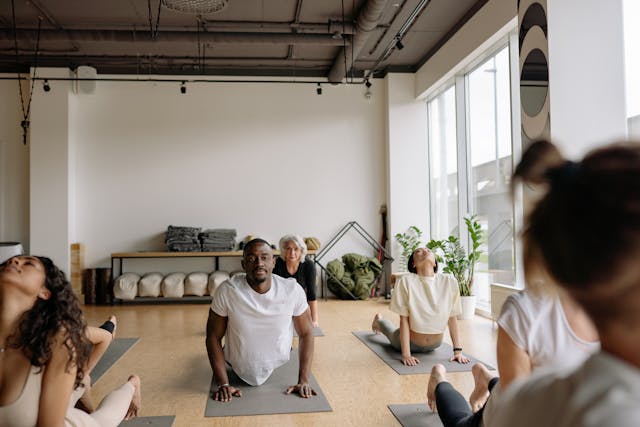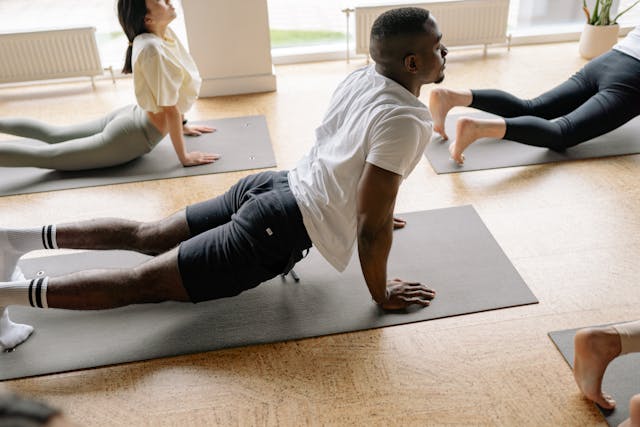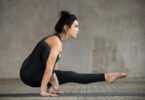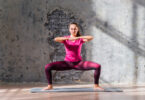Introduction
Yoga, a practice deeply rooted in ancient Indian philosophy, offers numerous benefits for both mind and body. For men, yoga can be particularly beneficial, providing a means to enhance physical fitness, reduce stress, and improve overall wellness.
Getting Started
Starting yoga can be a beneficial practice for men of all ages and fitness levels. Yoga is not only about flexibility; it also enhances strength, improves balance, reduces stress, and can lead to better overall health. Here’s a guide to help men begin their yoga journey:
1. Understand the Benefits
Before starting, it’s helpful to know the benefits of yoga:
- Physical Health: Strengthens muscles, increases flexibility, improves posture, and boosts stamina.
- Mental Clarity: Helps manage stress, enhances focus, and promotes a calmer mindset.
- Injury Prevention: Stretching in yoga helps prevent injuries by increasing the range of motion and muscle flexibility.
2. Choose the Right Style
There are several styles of yoga, and choosing one that aligns with your goals and fitness level is crucial:
- Hatha Yoga: Great for beginners due to its slower pace and focus on basic postures.
- Vinyasa Yoga is a more dynamic style that integrates breath with movement. It is suitable for those looking for a more active workout.
- Iyengar Yoga: Focuses on precision and alignment, using props like blocks and straps to help with form.
- Ashtanga Yoga is a rigorous style that follows a specific sequence of postures and is great for building core strength and stamina.
3. Get the Necessary Equipment
The great thing about yoga is that you don’t need much to get started. However, a few items can help:
- Yoga Mat: Provides cushioning and traction while performing poses.
- Comfortable Clothing: Wear something that allows for easy movement and is breathable.
- Yoga Blocks and Straps: These can help beginners perform poses with better alignment and are especially useful for those with limited flexibility.
4. Start With Basic Poses
Begin with simple poses to build a foundation before moving to more complex ones. Here are a few to start with:
- Mountain Pose (Tadasana)
- Downward Facing Dog (Adho Mukha Svanasana)
- Warrior Poses (Virabhadrasana I and II)
- Tree Pose (Vrikshasana)
5. Join a Class or Follow Online Tutorials
For beginners, it’s often helpful to join a class or follow online tutorials to ensure you’re doing poses correctly. This can prevent injuries and help you gain more from the practice. Look for classes labeled as beginner or intro.
6. Listen to Your Body
Yoga should not be painful. While it’s normal to experience some discomfort while stretching or holding poses, you should never feel pain. Listen to your body and adjust your poses as needed. Remember, flexibility and strength will come with time.
7. Be Consistent
Consistency is key in yoga. Try to practice regularly, even if it’s just a few minutes a day. Over time, you’ll notice improvements in your flexibility, strength, and mental well-being.
8. Engage with the Community
Yoga has a vast community, both online and offline. Engaging with other yogis can provide support, enhance your practice, and keep you motivated.
Starting yoga is a step toward a healthier and more balanced life. Remember, yoga is a personal journey, so move at your own pace and enjoy the process.
Basic Poses for Beginners
Starting yoga can be an enriching experience, and learning some basic poses is an excellent way to begin. Here are several fundamental yoga poses suitable for beginners. These poses help build strength, increase flexibility, and develop your understanding of yoga principles.
1. Mountain Pose (Tadasana)
This pose teaches basic alignment and is a starting point for other standing poses.
- How to Do It:
- Stand with feet together, arms at your sides.
- Distribute your weight evenly across your feet.
- Engage your core, and lift your chest while relaxing your shoulders.
- Your arms should be active, fingers reaching down.
- Hold and breathe.
2. Downward-Facing Dog (Adho Mukha Svanasana)
A foundational pose that strengthens the whole body.
- How to Do It:
- Start on your hands and knees.
- Lift your hips up and back, forming an inverted V shape.
- Press firmly into your hands and distribute your weight evenly between your hands and feet.
- Keep your head between your arms and look back at your feet.
- Hold and breathe.
3. Warrior I (Virabhadrasana I)
Builds lower body strength and improves focus.
- How to Do It:
- Step one foot back, about 3 to 4 feet apart, with the front foot pointing forward and the back foot at about a 45-degree angle.
- Bend your front knee, keeping it over the ankle.
- Raise your arms overhead, palms facing each other.
- Hold and breathe, then switch sides.
4. Warrior II (Virabhadrasana II)
Enhances stability and increases leg and arm strength.
- How to Do It:
- From Warrior I, extend your arms to the sides, parallel to the ground.
- Turn your head to look over your front hand.
- Keep your front knee bent and your back leg straight.
- Hold and breathe, then switch sides.
5. Tree Pose (Vrikshasana)
Improves balance and focus.
- How to Do It:
- Stand in Mountain Pose.
- Shift your weight onto one leg.
- Place the sole of your other foot on your inner thigh or calf (not the knee).
- Bring your hands together in prayer at your chest, or raise them above your head.
- Hold and breathe, then switch sides.
6. Child’s Pose (Balasana)
A resting pose that calms the mind and eases the back.
- How to Do It:
- Kneel on the floor, touch your big toes together, and sit on your heels.
- Separate your knees about hip-width apart.
- Exhale and lay your torso down between your thighs.
- Extend your arms forward or let them rest alongside your body.
- Hold and breathe.
7. Seated Forward Bend (Paschimottanasana)
Stretches the back and hamstrings.
- How to Do It:
- Sit on the floor with your legs extended.
- Inhale and raise your arms above your head.
- Exhale and hinge at the hips to lean forward, reaching for your feet.
- Hold and breathe.
Tips for Beginners:
- Warm-Up: Always begin with a warm-up to reduce the risk of injury.
- Breathing: Focus on your breath; it should guide your movement in yoga.
- Modifications: Use props like blocks or straps to help achieve poses until your flexibility increases.
- Consistency: Regular practice will help improve your skills more quickly.

Yoga Sequences for Beginners
Creating a yoga sequence can help beginners establish a steady practice by building a routine that enhances flexibility, strength, and mindfulness. Here are a few beginner-friendly yoga sequences that you can try at home. Each sequence has a specific focus and can be adjusted according to your comfort and time availability.
1. Morning Wake-Up Sequence
This sequence energizes the body and prepares you for the day.
- Mountain Pose (Tadasana)
- Upward Salute (Urdhva Hastasana)
- Standing Forward Bend (Uttanasana)
- Half Standing Forward Bend (Ardha Uttanasana)
- Downward-Facing Dog (Adho Mukha Svanasana)
- Plank Pose
- Cobra Pose (Bhujangasana)
- Child’s Pose (Balasana)
Flow: Start with the Mountain Pose, flow into an Upward Salute to stretch the body, then hinge at the hips into a Forward Bend. Move into Half Forward Bend, then step back into Downward-Facing Dog and Plank Pose. Lower your body to the floor and rise into Cobra Pose. Finish by sitting back into Child’s Pose to relax and stretch the back.
2. Evening Wind-Down Sequence
This sequence is great for relaxing and unwinding before bed.
- Child’s Pose (Balasana)
- Cat-Cow Stretches (Marjaryasana and Bitilasana)
- Seated Forward Bend (Paschimottanasana)
- Supine Spinal Twist (Supta Matsyendrasana)
- Legs-Up-the-Wall Pose (Viparita Karani)
Flow: Start in Child’s Pose to begin relaxation. Shift to all fours for several rounds of Cat-Cow Stretches to loosen the spine. Sit and extend your legs for the Seated Forward Bend. Lie on your back, bring your knees to your chest, and gently twist them to each side in the Supine Spinal Twist. End with Legs-Up-the-Wall Pose for a soothing finish.
3. Strength-Building Sequence
Focus on building core strength and improving overall muscle tone.
- Mountain Pose (Tadasana)
- Chair Pose (Utkatasana)
- Warrior II (Virabhadrasana II)
- Plank Pose
- Boat Pose (Navasana)
- Bridge Pose (Setu Bandha Sarvangasana)
Flow: Begin in Mountain Pose to ground and center. Move into Chair Pose to build heat in the thighs. Step into Warrior II to strengthen the legs and improve balance. Transition to Plank Pose to engage the core, followed by Boat Pose for abdominal strength. Complete the sequence with Bridge Pose to open the chest and strengthen the lower back.
4. Flexibility and Relaxation Sequence
This sequence is gentle and aimed at increasing flexibility and calming the mind.
- Easy Pose (Sukhasana)
- Butterfly Pose (Baddha Konasana)
- Seated Forward Bend (Paschimottanasana)
- Happy Baby Pose (Ananda Balasana)
- Corpse Pose (Savasana)
Flow: Start seated in Easy Pose for a few breaths to settle in. Move to Butterfly Pose to open the hips. Stretch the back and hamstrings in Seated Forward Bend. Lie on your back and engage in Happy Baby Pose to relax the spine and hips. End with several minutes in Corpse Pose for deep relaxation.
Tips for Practicing Yoga Sequences
- Consistency: Practice regularly to see progress in your flexibility, strength, and mindfulness.
- Breathing: Coordinate your movements with your breath, inhaling and exhaling fully to support transitions and deepen poses.
- Listen to Your Body: Modify poses and sequences to suit your body’s needs and limitations. Use props like blocks, straps, or cushions as needed.
Integrating Yoga Into Your Daily Routine
Integrating yoga into your daily routine can be a transformative way to enhance physical health, mental clarity, and overall well-being. Here are practical steps and tips to help you seamlessly incorporate yoga into your everyday life, making it a consistent and enjoyable practice.
1. Set Realistic Goals
Start with attainable goals, such as practicing yoga for 10 to 15 minutes each day. As yoga becomes a regular part of your routine, you can gradually increase the duration and complexity of your practice.
2. Choose the Right Time
Identify a time of day that works best for your schedule and energy levels. Many people find practicing yoga in the morning helps set a positive tone for the day, while others may prefer evening sessions to unwind and relax before bed.
3. Create a Comfortable Space
Designate a specific area in your home for yoga. It doesn’t have to be large; just ensure it’s clean, quiet, and free from distractions. Having a dedicated space can motivate you to practice regularly.
4. Incorporate Yoga into Daily Activities
Yoga doesn’t always mean performing a full sequence of poses. You can integrate yoga principles into daily life:
- Breathing Exercises: Practice deep breathing while in a meeting or stuck in traffic.
- Mini-Stretches: Do simple stretches or poses during breaks at work or while watching TV.
- Mindfulness Practices: Apply mindfulness during regular activities, like eating or walking, focusing fully on the present moment.
5. Use Resources Wisely
Leverage a variety of resources to keep your practice fresh and engaging. Use online videos, apps, or books to find new poses, sequences, and breathing techniques. This variety can help maintain your interest and commitment to yoga.
6. Join a Community
Whether it’s a local class or an online forum, being part of a yoga community can provide support and motivation. Sharing experiences and tips with others can enhance your practice and keep you accountable.
7. Be Flexible and Patient
Some days will be easier than others to fit yoga into your schedule. Be flexible with your routine and patient with your progress. If you miss a day, don’t be discouraged; just return to your practice the next day.
8. Apply Yoga Principles Throughout the Day
Yoga is more than physical poses; it’s also about cultivating a balanced, mindful approach to life. Try to incorporate yoga’s ethical principles, such as non-harm (ahimsa) and truthfulness (satya), into your daily interactions and decisions.
9. Track Your Progress
Keeping a yoga journal can help you track your progress, set goals, and reflect on how your practice affects your body and mind. Note any new poses you learn, how they make you feel, and any insights or challenges you encounter.
10. Make It Enjoyable
Above all, your yoga practice should be something you look forward to. Modify your practice to include your favorite poses or sequences that feel particularly good. If you enjoy your yoga time, you’ll be more likely to stick with it long-term.
The Mental and Emotional Benefits of Yoga
Yoga is renowned not only for its physical benefits but also for its profound positive impact on mental and emotional health. Engaging in regular yoga practice can lead to significant improvements in overall well-being, stress reduction, and emotional resilience. Here’s an overview of some key mental and emotional benefits of yoga:
1. Stress Reduction
Yoga helps decrease the levels of cortisol, the stress hormone, in the body. Practices like deep breathing, meditation, and gentle physical activity are effective tools in managing acute and chronic stress. These activities promote relaxation and trigger the body’s natural relaxation response, which can help alleviate feelings of anxiety.
2. Enhanced Mood and Emotional Regulation
Regular yoga practice is associated with increased production of serotonin and other neurotransmitters that boost mood and feelings of happiness. Yoga also helps in regulating emotions by enhancing mindfulness, which involves observing thoughts and feelings without judgment. This mindfulness can help decrease emotional reactivity and promote a more balanced emotional state.
3. Improved Concentration and Mental Clarity
Yoga poses and breathing exercises enhance blood circulation, including to the brain, which can help improve cognitive functions such as concentration, memory, and attention span. The meditative aspects of yoga encourage a focus on the present moment, which helps clear the mind of clutter and distraction.
4. Reduction in Symptoms of Depression and Anxiety
Several studies have shown that yoga can reduce symptoms of depression and anxiety. The combination of movement, breath work, and meditation can have therapeutic effects, influencing neurotransmitter levels and decreasing inflammatory markers often associated with mood disorders.
5. Increased Self-Awareness and Self-Esteem
Yoga encourages a deeper connection with the self. Through regular practice, individuals often experience a greater awareness of their body and emotions. This self-awareness can lead to improved self-esteem and a more positive self-image, as practitioners learn to view themselves with compassion and acceptance.
6. Better Sleep
Yoga can significantly improve sleep quality due to its ability to calm the nervous system. Practices like gentle yoga or Yoga Nidra (a form of guided relaxation) can help quiet the mind and prepare the body for sleep, making it easier to fall asleep and stay asleep.
7. Emotional Healing and Trauma Recovery
Certain styles of yoga, such as trauma-informed yoga, are specifically designed to help individuals deal with emotional pain and traumatic experiences. These practices often focus on establishing safety and trust in the body, which can be crucial in the healing process.
8. Fostering Community and Connectedness
Participating in yoga classes can help build a sense of community and connectedness with others. This social aspect can be especially beneficial for emotional health, as it combats loneliness and isolation by providing a shared, supportive space to engage with others.
9. Enhancement of Mindfulness and Presence
The practice of yoga promotes an increased state of mindfulness, which involves paying attention to the present moment with acceptance. This can lead to greater life satisfaction by reducing the tendency to ruminate on the past or worry about the future.
10. Holistic Self-Care
Yoga encourages holistic self-care, integrating physical, mental, and emotional aspects of health. This holistic approach can foster a healthier relationship with oneself and with others, leading to more balanced living.
Joining a Yoga Class vs. Practicing at Home
Pros and Cons
Each option has its benefits and drawbacks. Classes offer professional guidance, while home practice provides flexibility and convenience.
Advanced Tips as You Progress
Deepening Your Practice
Advanced poses and meditation can help deepen your yoga practice as you become more proficient.
Exploring New Styles
As you progress, exploring different styles can keep the practice engaging and challenging.
Yoga and Diet
Nutrition Tips for Yoga Practitioners
Eating light meals before yoga can help maintain energy and comfort during practice.
Foods to Enhance Yoga Practice
Incorporating whole, unprocessed foods into your diet can support your yoga journey by boosting energy and health.
Yoga Retreats and Workshops
Benefits of Attending Retreats
Retreats offer intensive practice and can significantly enhance your understanding and skills.
How to Choose the Right One
Consider your level of practice and personal goals when selecting a retreat.
Common Yoga Myths Debunked
Misconceptions About Yoga for Men
Addressing common myths, such as yoga being too gentle or not “masculine” enough.
Related Article:
To provide a richer experience and additional value to our readers, below are suggested internal linking opportunities using relevant articles from the same website:
- For those looking to understand more about the fundamental aspects of yoga, consider reading about the benefits and practices of Hatha Yoga, which is ideal for beginners and seasoned practitioners.
- If you’re interested in yoga that emphasizes strength and flexibility, learn more by exploring the best yoga poses for weight loss and toning.
- The article on how yoga benefits the mind and spirit can be particularly enlightening if you want to enhance your knowledge of meditative and restorative practices.
- For those intrigued by more dynamic yoga practices, consider reading about the transformative power of Vinyasa Yoga.
FAQs
How Should a Beginner Start Yoga?
Understand the Basics: Learn about different styles of yoga and what they entail. This includes familiarizing yourself with the basic principles, common poses, and the philosophy behind the practice.
Choose the Right Style: For beginners, Hatha, Iyengar, or Vinyasa yoga are good starting points as they offer a mix of poses and techniques that help build a strong foundation.
Find Beginner Classes: Look for classes labeled as “beginner” or “introductory” to ensure the pace and content are suitable for those new to yoga.
Gather Necessary Equipment: At minimum, you’ll need a yoga mat. Comfortable clothing that allows for unrestricted movement is also essential. Other helpful items might include yoga blocks and a strap.
Start Slowly: Begin with shorter sessions, perhaps 20-30 minutes long, and gradually increase the duration as you become more comfortable with the poses and sequences.
Practice Regularly: Consistency is key in yoga. Try to practice several times a week to improve flexibility, strength, and balance.
Can a Man Learn Yoga?
Absolutely! Yoga is for everyone, regardless of gender. Many men find yoga to be an excellent way to relieve stress, improve flexibility, enhance strength, and reduce the risk of injury. It can also be a powerful tool for mental clarity and emotional stability.
What Yoga is Best for Men?
While any style of yoga can be beneficial, some types might resonate more with men, especially those new to the practice:
Ashtanga Yoga: Known for its rigorous and physically demanding sequences, it’s great for building strength and endurance.
Vinyasa Yoga: This style focuses on the flow of movement linked with breath, offering a dynamic and athletic form of yoga.
Iyengar Yoga: With its emphasis on alignment and detail, using props to aid in form, it’s ideal for beginners to understand poses correctly and deeply.
How Long Does It Take for a Man to Get Good at Yoga?
The time it takes to get “good” at yoga can vary widely among individuals. It depends on various factors such as the frequency of practice, physical condition, flexibility, and commitment to learning. Generally, with regular practice—about 2-3 times a week—you might start to feel more confident and notice improvements in your flexibility and strength within a few months. Mastery of more complex poses and a deeper understanding of yoga’s mental and spiritual aspects can take years, but the journey itself is highly rewarding.
Conclusion
Yoga offers a holistic approach to fitness that men of all ages can benefit from. It encourages physical and mental health and is a rewarding practice that adapts to your growth and changes with you.







